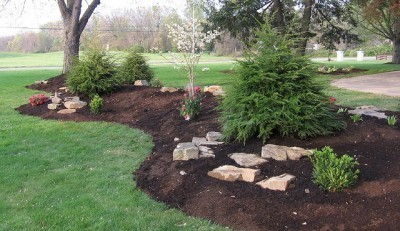






There are no special rules to creating berms; however, there are a few simple guidelines to follow that might make this endeavor easier. Before you begin construction of the berm, plan accordingly. Consider drainage within the area surrounding the proposed berm as it may affect drainage patterns by redirecting runoff to other areas or encourage pooling after heavy rains.
Generally, a berm should be about four to five times as long as it is high, gradually trailing or spreading out into the lawn. Berms can be created with varying sizes and with more than one peak. The depth is normally up to you; however, most berms are generally no higher than 18 to 24 inches. Although most berms are given a crescent-looking shape, as long as they fit into or follow the natural flow of the surrounding landscape, anything goes. Bear in mind, however, that curving berms are usually much more natural looking.
Berms can be continual and flowing throughout the lawn, or they can be edged with attractive stones, plants, etc. Adding a border to the berm also help stop the soil eroding into the lawn. To create the berm, start by outlining its shape with flour, spray paint, or chalk, just as you would for a typical garden bed. Dig out the ground to remove the sod. Load the bottom of the berm with your choice of fill (or simply use dirt), packing down around it with soil. Continue piling up the soil to create a sloping mound. When shaping the berm, pile the dirt into a pleasing shape that mimics the surrounding landscape.
Like any landscape element, berms should enhance the overall design, blending in naturally, not sticking out like a sore thumb. Therefore, as your berm begins to take shape, step back to see how it looks. If the berm doesn’t appear natural, now is the time to correct it. For instance, the transition between your existing landscape and the slope of the berm should be a gradual one. If it looks more like a speed bump or a high ridge, you’ll have to rearrange the soil so that it gradually spills out into the lawn.
In addition, the berm’s peak should be located near one end rather than in the middle. Varying its slope, height, and width creates a more natural effect. Make sure you tamp the berm firmly. Tamping berms is important in order to prevent the possibility of collapse as well as to keep any air pockets from heaving up plants and drying them out. It usually helps to water the newly built berm and then tamp it again to ensure that it doesn’t develop sinkholes. If this is the case, simply add more soil and keep tamping until it’s relatively solid.
Berms make lovely sites for gardens, and since most people incorporate plants within their berms, you’ll want to determine beforehand what types of plants you want and where. Keep in mind that berms, regardless of size, may have microclimates that will ultimately affect your plant selections. For instance, since water drains more quickly at the top of the berm, choose plants that are tolerant of drier conditions. Likewise, moisture-loving plants might enjoy a permanent location at the bottom.
Since berms are sloped, you should also consider the overall temperatures throughout the year. For instance, those facing south or west are warmer, whereas those facing north or east are cooler.
Plants should always emphasize the berm’s form. Incorporate plants that vary in height, color, texture, and form. This provides the berm with year-round interest. When placing plants within the berm, taller varieties can be planted along the backside with the shorter ones planted on the top and down the sides, depending on its overall shape. Even small trees and shrubs can be incorporated into the berm.
Applying mulch within the berm is important for those with plantings. Not only will it help to slow down water, reducing erosion, but it also provides insulation. Shredded wood usually works well on berms, as it is less likely to wash down during heavy rains. This type of mulch also blends well into most landscape settings. Edging should be compatible to its form and surroundings as well.
Landscape Gardening And The Benefits One Receives
Gardening And Landscaping: The Benefits Of Landscape Design Software
Creating The Perfect Flower Bed
A Brief History of the Landscape Garden
Using A Black And Decker Hedge Trimmer To Landscape Your Home
Technology and Garden Gadgets – Tips On Using Technology In Landscape Design
Copyright © www.100flowers.win Botanic Garden All Rights Reserved